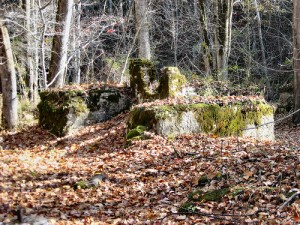Often lost in the North Shore Road (Road to Nowhere) controversy were the visceral ties to community and sense of place.
There is a kind of melancholy intermingled with the surreal beauty of Lake Fontana. The lake is beautiful, no doubt, but it is an unnatural beauty when one turns one’s mind to the reality. The reality is that the lake is superimposed over thousands of acres of mountain peaks and valleys. It has swallowed up three rivers — the Nantahala, Tuckasegee and Little Tennessee — along with their confluences and dozens of smaller creeks and streams that emptied into them.
The morning I was there started out calm. The water was still like a droplet spread over dark glass. I felt if I stared into that limpid stillness I might see children playing in the yard of their tiny mountain school; or families visiting in front of their neighborhood church; or stout, weathered mountain farmers loading supplies on crude mule-drawn wagons for the trip back up the holler.
“My dad’s store was right there,” David Monteith said, pointing his finger straight down over the side of his pontoon boat. We were sitting in 100 feet of water near the mouth of Noland’s Creek. I was on the lake that morning as a guest of David and his wife, Ellen. I was there to learn a little of the dynamic history of the bustling communities silenced by these still waters and to follow the legendary North Shore Road from Land’s Creek to Fontana Dam.
In the late 1920s and 1930s that area of Swain County, now either under water or part of the Great Smoky Mountains National Park, was home to more than 6,000 people. Monteith is a member of the North Shore Road Association and one of many Swain County residents who feel the federal government and National Park Service are bound by a 1943 contractual agreement to build a north shore road from Bryson City to Fontana Dam. His family and his wife’s, the Calhouns, both have deep roots in the area.
We beached the boat at Dorsey Creek, walked up the bank and hit the old roadbed of N.C. 288, the north shore road. We walked the road a short way to where a chimney was still standing. It was the house where Ellen’s father, W.W. Calhoun, was born.
The history lesson was commingled with incredible scenic beauty and abundant wildlife.
We weren’t five minutes out of Almond’s boat dock when we noticed a large dark raptor along the shoreline. Binoculars revealed an immature bald eagle. Only minutes farther down the lake we spotted the unmistakable white tail and head of a mature bald eagle. The bird perched in a pine and let us approach close enough for a good look.
David and Ellen keep a keen eye on the lakeshore. They say it is common to see deer, bear, wild hogs and other wildlife along the edge of the lake. David said he has dipped up coons and squirrels and other critters from the middle of the lake in his dip net and given them a lift to the other shore.
As we motored into one cove, we saw about 10 wild turkeys scramble up the bank and disappear into the woods. Later in the day as we cruised the lake Ellen saw some movement that turned out to be a couple of coyotes. We also saw migrating blue-winged teal and a group of wood ducks.
Hiking the trail along Hazel Creek to Proctor we stopped and studied the area where the creek and lake mingled. There where the water eddied was a three- to four-pound large mouth bass keeping a low profile just beneath the debris and leaf litter that collected at the eddy line.
The jumble of emotions Fontana must stir for David and Ellen are hard to comprehend. There is no doubt the lake is a joy to them. It is ingrained in their essence. They scrambled over its banks, waded its streams and splashed in its waters as children. As adults they have fished and boated every nook and cranny. They have camped along its shore from one end to the other. As descendants they motor across to visit chimneys and graveyards that speak to them of family and heritage.
The road that goes nowhere for many takes the Monteiths and other families of Swain County back in time to a place of roots. The lake they play on and fish on now, that provides so much beauty and joy, is the placid opaque lid that seals the watery tomb of the past.

